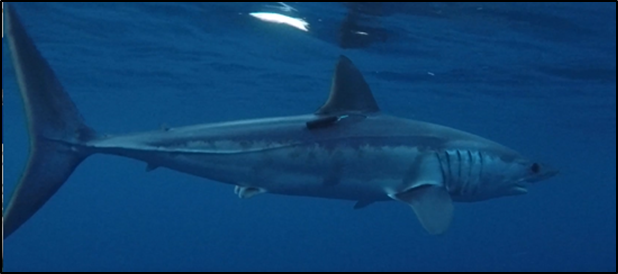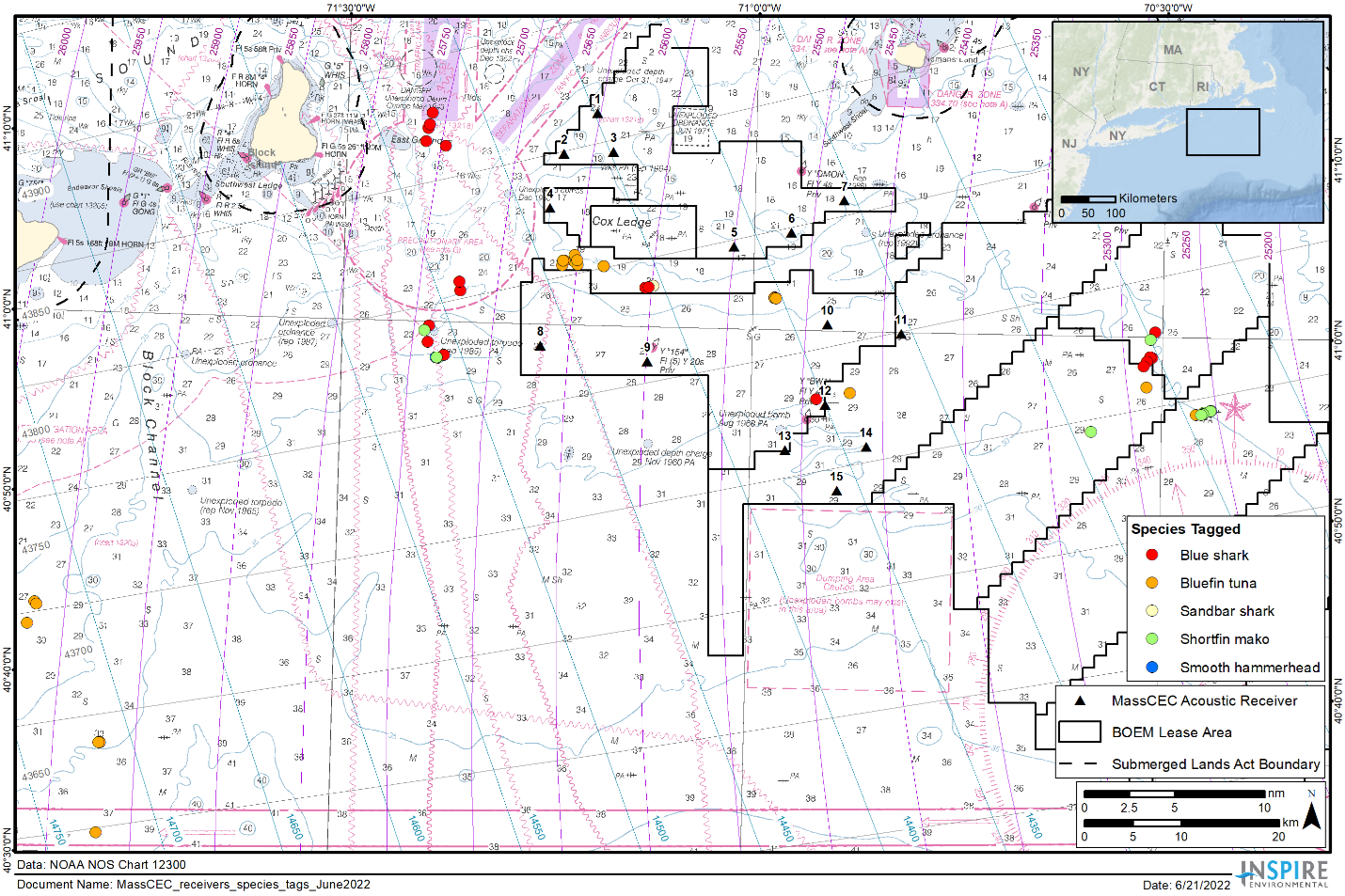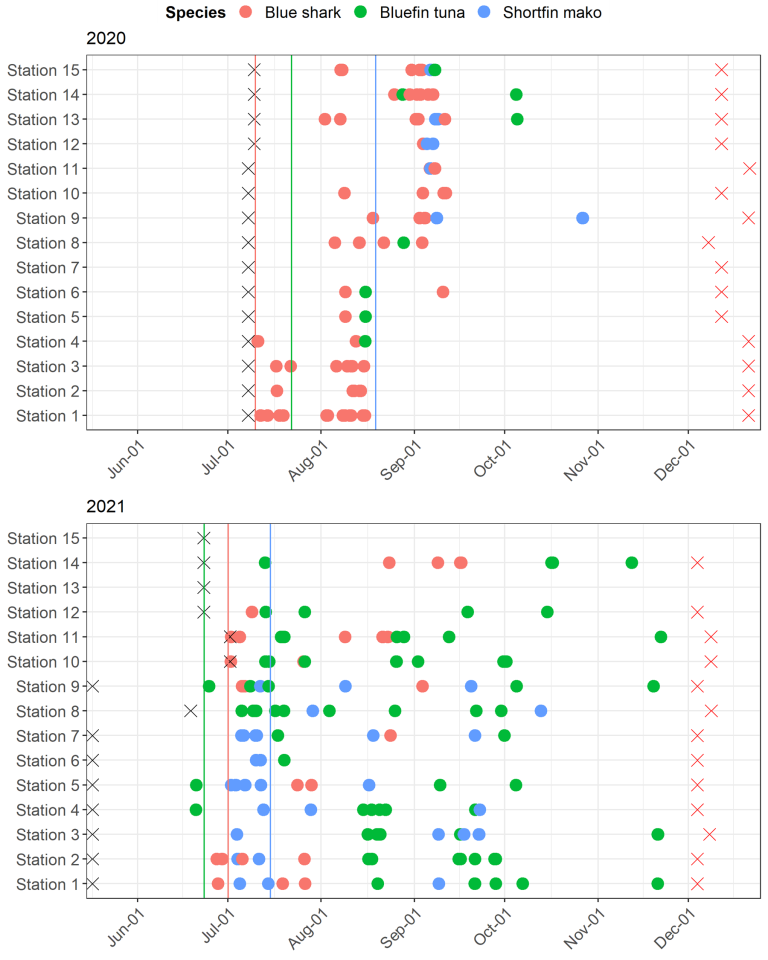
The offshore waters of southern New England have long supported populations of highly migratory fish species, or “HMS” for short — including sharks, tunas, and billfishes — during the warm months of summer and fall. These productive waters not only serve as important feeding grounds and migratory corridors for numerous pelagic species but are also popular recreational fishing grounds. Each year hundreds of fishing vessels actively pursue iconic HMS like bluefin and yellowfin tuna, white marlin, and shortfin mako sharks across this region. However, these fish and recreational fishermen will soon have to share southern New England offshore waters with a new resident: offshore wind turbines.
Currently, the extent to which offshore wind development and operations will affect HMS, and HMS-directed fisheries, by extension, is not well understood. For example, it’s unclear whether or how the presence of wind turbine generators will affect the residency or movements of HMS in southern New England. Will HMS foraging success be impacted? Will HMS be displaced from wind energy areas due to the singular or cumulative effects sourced from pre-construction surveying, wind farm construction, or electromagnetic fields produced during operation?
As a first step towards answering these questions, INSPIRE Environmental and the Anderson Cabot Center for Ocean Life at the New England Aquarium, with funding from the Massachusetts Clean Energy Center, conducted a pilot acoustic telemetry monitoring study on HMS presence and movement in the southern New England wind energy area. The specific goals of this study were two-fold: (1) to collect baseline (or pre-construction) information about when and how HMS use popular fishing grounds within the area leased for offshore wind development, and (2) to test the performance of acoustic telemetry as a long-term monitoring technique.
What is acoustic telemetry?
Acoustic telemetry is a popular technique used to study the movements of marine species. It relies on the interaction between two electronic devices: an acoustic transmitter and an acoustic receiver. Acoustic transmitters are small electronic tags attached to the fish that emit unique, coded pings capable of being detected when a tagged animal swims within range of acoustic receivers — stationary hydrophones that continually listen for and record those pings. Thus, by placing multiple acoustic receivers throughout an area (see Figure 1), researchers can collect information about the presence, persistence, and movements of tagged animals as they pass through and/or spend time within that area. Remarkably, acoustic transmitters can remain active for several years, which provides an opportunity to learn about how individual species, or even individual fish, use the study site over extended periods of time.
Working in cooperation with commercial and charter sport fishermen, the research team deployed an array of 15 acoustic receivers near popular recreational fishing grounds in southern New England and tagged 60 fish — primarily bluefin tuna, shortfin mako sharks, and blue sharks — during June to November of 2020 and 2021 (Figure 1).

What did our data show?
Despite catching and tagging HMS fish over a vast area — in some cases 80 kilometers away from the closest receiver — a great deal of information about HMS presence and movements in the study site was gathered. In each year, bluefin tuna, shortfin mako, and blue sharks were detected by nearly every acoustic receiver. Some individuals were observed briefly as they moved through the study site and others remained in the area for multiple days at a time (Figure 2). Tagged fish also exhibited extensive movements both within the southern New England region as a whole and within the acoustic receiver array itself. Numerous individuals traveled into the acoustic array from distant release locations and others made repeated movements between acoustic receivers over the course of a few days. Receiver detection data also revealed that multiple tagged individuals of each species were present in the study site in both 2020 and 2021, demonstrating site fidelity and the importance of this region to HMS seasonal migration.
In addition to documenting HMS movements, the study also provided insight into the environmental conditions — such as surface and bottom water temperature — that are evident when HMS are present in the region. By participating in the Mid Atlantic Acoustic Telemetry Observation System, a group that facilitates the sharing of acoustic telemetry data, the research team was also able to opportunistically monitor the presence of several other marine species that traveled into the acoustic array after having been tagged by other researchers, including Atlantic cod, Atlantic sturgeon, blueback herring, winter flounder, and loggerhead sea turtles.
Looking Ahead
Although there were a few bumps along the way — like a global pandemic — the ability of acoustic telemetry to collect valuable baseline data on how HMS utilize the southern New England wind energy area in both space and time rendered this study a success and affirmed that telemetry can be an effective long-term, multi-species monitoring tool. More work is needed to fully understand how these highly mobile fishes may be impacted by the full scale of the offshore wind development planned in the region.
The success of our pilot study catalyzed the development of a broad-scale, regional acoustic telemetry project, supported by multiple wind developers, that will monitor HMS across the entirety of the southern New England wind energy area, including through the early stages of construction and turbine operation in some lease areas. Only time will tell if or how HMS are impacted by the construction and operation of offshore wind farms, but acoustic telemetry will be our ears in the water, listening every step of the way

Colored circles indicate when that species was observed at a given receiver. Colored vertical lines represent the time individuals of each species were first tagged in each year. The black “X” represents the time when the receiver was deployed, and the red “X" represents the time it was removed for the season.